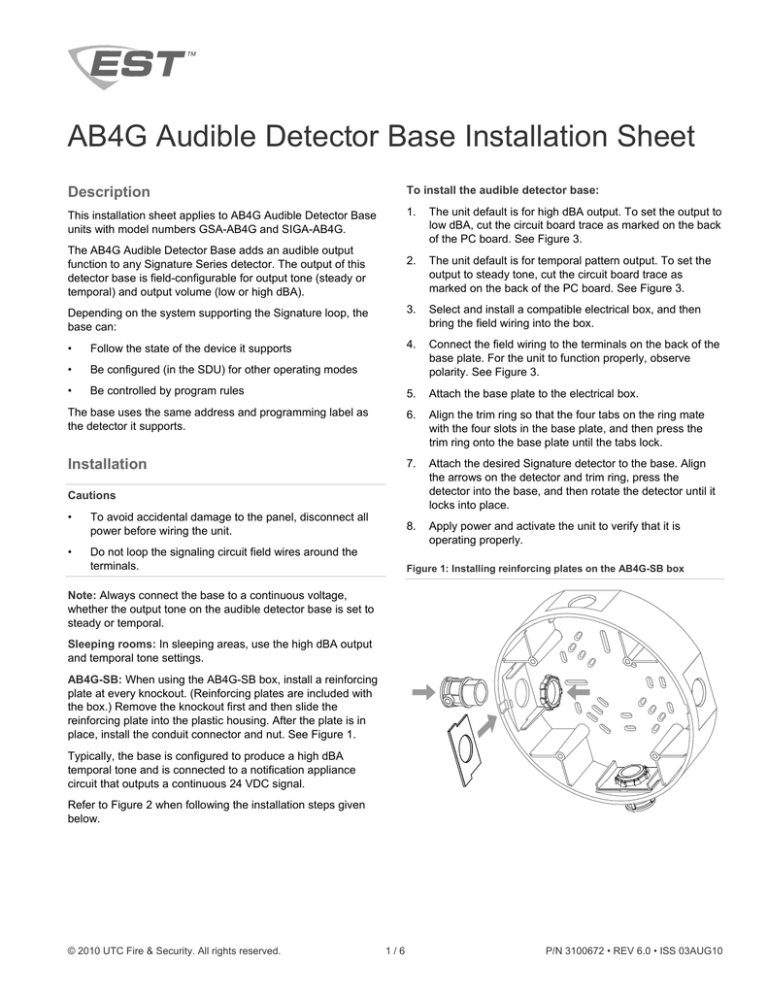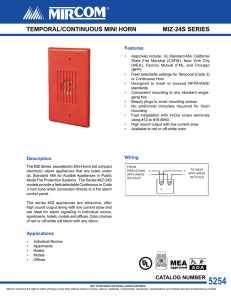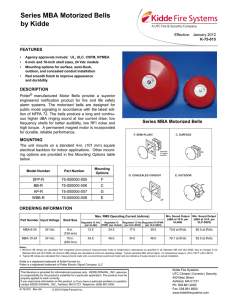
AB4G Audible Detector Base Installation Sheet
Description
To install the audible detector base:
This installation sheet applies to AB4G Audible Detector Base
units with model numbers GSA-AB4G and SIGA-AB4G.
1.
The unit default is for high dBA output. To set the output to
low dBA, cut the circuit board trace as marked on the back
of the PC board. See Figure 3.
2.
The unit default is for temporal pattern output. To set the
output to steady tone, cut the circuit board trace as
marked on the back of the PC board. See Figure 3.
Depending on the system supporting the Signature loop, the
base can:
3.
Select and install a compatible electrical box, and then
bring the field wiring into the box.
•
Follow the state of the device it supports
4.
•
Be configured (in the SDU) for other operating modes
Connect the field wiring to the terminals on the back of the
base plate. For the unit to function properly, observe
polarity. See Figure 3.
•
Be controlled by program rules
The AB4G Audible Detector Base adds an audible output
function to any Signature Series detector. The output of this
detector base is field-configurable for output tone (steady or
temporal) and output volume (low or high dBA).
5.
Attach the base plate to the electrical box.
The base uses the same address and programming label as
the detector it supports.
6.
Align the trim ring so that the four tabs on the ring mate
with the four slots in the base plate, and then press the
trim ring onto the base plate until the tabs lock.
Installation
7.
Attach the desired Signature detector to the base. Align
the arrows on the detector and trim ring, press the
detector into the base, and then rotate the detector until it
locks into place.
Apply power and activate the unit to verify that it is
operating properly.
Cautions
•
To avoid accidental damage to the panel, disconnect all
power before wiring the unit.
8.
•
Do not loop the signaling circuit field wires around the
terminals.
Figure 1: Installing reinforcing plates on the AB4G-SB box
Note: Always connect the base to a continuous voltage,
whether the output tone on the audible detector base is set to
steady or temporal.
Sleeping rooms: In sleeping areas, use the high dBA output
and temporal tone settings.
AB4G-SB: When using the AB4G-SB box, install a reinforcing
plate at every knockout. (Reinforcing plates are included with
the box.) Remove the knockout first and then slide the
reinforcing plate into the plastic housing. After the plate is in
place, install the conduit connector and nut. See Figure 1.
Typically, the base is configured to produce a high dBA
temporal tone and is connected to a notification appliance
circuit that outputs a continuous 24 VDC signal.
Refer to Figure 2 when following the installation steps given
below.
© 2010 UTC Fire & Security. All rights reserved.
1/6
P/N 3100672 • REV 6.0 • ISS 03AUG10
Figure 2: Installing the Audible Detector Base
Figure 3: Output configuration and basic wiring
4
AUX_RISER_IN
AUX_RISER_IN
SLC_IN
SLC_IN
AUX_RISER_OUT
AUX_RISE_OUT
SLC_OUT
SLC_OUT
1.
2.
3.
4.
5.
6.
7.
Wiring diagram
See Figure 3. For additional wiring details, see the applicable
control panel installation manual.
AUX-RISER_IN (from previous base or 24 VDC primary or
auxiliary power supply that is UL/ULC listed for fire protective
signaling systems)
Volume setting: default is high volume; cut per item 4 for low
volume
Tone Setting: default is temporal pattern: cut per item 4 for steady
tone
To configure output volume or tone, cut the circuit board as
shown
AUX-RISER_OUT To next base or EOL relay
SLC_OUT to next intelligent addressable device
SLC_IN from intelligent addressable controller or previous device
Applications
This section describes applications typically found in the North
American marketplace that apply to the AB4G and Signature
audible bases. For additional examples, see the applicalbe
control panel application manual.
Local alarm signaling application
Figure 4 shows the components and wiring required for a local
alarm signaling application.
All other audible detector bases on the same riser remain silent
until their detectors are activated. The audible detector base
remains audible until the smoke clears and the control panel is
reset.
2/6
P/N 3100672 • REV 6.0 • ISS 03AUG10
Zone alarm signaling application
Specifications
Figure 5 shows the components and wiring required for a zone
alarm signaling application.
Operating voltage
24 VDC or 24 VFWR, nominal
Current
Operating
Supervisory
See Table 1
DC = 1.46 mA, FWR = 2.15 mA
Default settings
Output volume
Output tone
High dBA
Temporal pattern
Sound level output
ULC
UL
See Table 2
See Table 3
Resonant frequency
3.2 kHz
Audible directional
characteristics
See Table 4 and Table 5
For more information about the Auto Signal Silence timer
function, and if the CRR can be programmed to silence the
panel, see the applicalbe control panel manual.
Temporal pattern
0.5 s on, 0.5 s off, 0.5 s on, 0.5 s off, 0.5 s
on, 1.5 s off, repeat cycle
Compatible detectors
All Signature Series detectors [1]
Synchronized alarm signaling application
Compatible electrical
boxes
AB4G-SB surface box for audible base;
4 in. square x 2-1/2 in. (64 mm) deep box;
3-1/2 in. octagonal x 2-1/2 in. (64 mm) deep
box; Standard European 100 mm² box
Wire size
12 to 18 AWG (0.75 to 2.50 mm²)
Sizes 16 and 18 AWG are preferred
Base diameter
6.8 in. (173 mm)
Base height from box
0.8 in. (21 mm)
Maximum distance
from ceiling (wall
mount)
12 in. (305 mm)
Environment type
Type A (Indoor only)
Operating environment
Temperature
Relative humidity
32 to 120°F (0 to 49°C)
0 to 93% noncondensing
Storage temperature
−4 to 140°F (−20 to 60°C)
In this application, use a CRR module to activate all the
audible detector bases in the same notification zone when any
one of their detectors activates (initiates an alarm event). The
audible detector base remains audible until:
•
Smoke is cleared from the active detectors and the control
panel is reset.
•
The control panel’s Auto Signal Silence timer expires.
•
It is silenced by the CRR that is programmed as a
silencing relay. (This function of the CRR is panel
dependent.)
Figure 6 shows the components and wiring required for a
synchronized alarm signaling application.
In this application, use a CRR module to activate all audible
detector bases when any alarm signal-initiating device
activates. Use a G1M-RM to synchronize the sound. The
audible detector base remains audible until:
•
Smoke is cleared from the active detectors and the control
panel is reset.
•
The control panel’s Auto Signal Silence timer expires.
•
It is silenced by the CRR that is programmed as a
silencing relay. (This function of the CRR is panel
dependent.)
For more information about the Auto Signal Silence timer
function, and if the CRR can be programmed to silence the
panel, see the applicalbe control panel manual.
[1] GSA series not CPD approved
Maintenance
Table 1: Operating current in mA (RMS)
Do not change the factory-applied finish.
Voltage
Low dBA
High dBA
16 VDC
17
28
24 VDC
24
41
33 VDC
31
52
16 VFWR
41
48
24 VFWR
51
60
33 VFWR
60
66
VDC = Volts direct current, regulated and filtered
VFWR = Volts full wave rectified
P/N 3100672 • REV 6.0 • ISS 03AUG10
3/6
Table 2: Sound pressure level per CAN/ULC-S525
Signal
Temporal
Steady
Table 5: Audible directional characteristics for EN 54-3
Voltage
High dBA
Low dBA
Reg. 24 VDC
95
91
Reg. 24
VFWR
99
95
Reg. 24 VDC
93
89
Reg. 24
VFWR
96
92
Table 3: Sound level output (dBA)
Signal
Voltage
Low dBA
Steady
Angle
16 VDC
71.5
78.1
24 VDC
75.5
80.7
33 VDC
78.5
83.1
16 VDC
75.5
81.7
24 VDC
79.5
84.5
33 VDC
81.8
86.5
Min 16 V
Max 33 V
Vertical Plane
Min 16 V
Max 33 V
Steady tone maximum volume (dBA)
15°
91.6
45°
97.5
102.6
82.9
87.6
75°
101.8
106.9
101.0
106.3
105°
100.1
105.4
99.8
105.1
135°
92.3
97.7
83.7
89.3
165°
92.7
98.2
86.2
92.0
High dBA
Reverberant room per UL 464 [1]
Temporal
Horizontal Plane
96.6
84.1
89.6
Temporal tone maximum volume (dBA)
15°
91.4
96.6
84.4
90.3
45°
97.3
102.5
81.5
86.9
75°
101.4
106.6
101.1
106.8
105°
100.6
105.8
100.1
105.8
135°
92.1
97.5
83.5
89.4
165°
92.1
97.4
87.9
93.5
Reverberant room per UL 268 and FM
Temporal
Steady
16 VDC
77.5
84.1
24 VDC
81.5
86.7
33 VDC
84.5
89.1
16 VDC
81.5
87.7
24 VDC
85.5
90.5
33 VDC
87.8
92.5
Regulatory information
Manufacturer
Authorized EU manufacturing representative:
UTC Fire & Security B.V.
Kelvinstraat 7, 6003 DH Weert, Netherlands
[1] For UL 464 applications, low dBA settings are for private mode only
Table 4: Audible directional characteristics [1]
Angle (degrees)
Output sound pressure level
90 (ref)
0 dBA
75 and 105
−3 dBA
65 and 110
−6 dBA
[1] Horizontal and vertical axes reflect the same pattern
ULC anechoic room
Edwards, A Division of UTC Fire & Security
Americas Corporation, Inc.
8985 Town Center Parkway, Bradenton, FL
34202, USA
Year of
manufacture
The first two digits of the product serial number
(located on the product identification label) are
the year of manufacture.
EN 54
EN 54-18: 2005
CPD [1]
0832-CPD-0940
UL ratings
Regulated 24 DC, Regulated 24 FWR
ULC ratings
20 to 31 VDC or 20 to 31 VFWR
North American
standards
Meets: UL 268, UL 464, CAN/ULC-S525, and
CAN/ULC-S529
Follow: CSA C22.1 and CAN/ULC-S524
This device is prohibited from being installed in a
dwelling unit as defined in the National Building
Code of Canada.
[1] GSA series not CPD approved
Contact information
For contact information, see www.utcfireandsecurity.com.
4/6
P/N 3100672 • REV 6.0 • ISS 03AUG10
Figure 4: Local alarm signaling application
AB4G
2
AB4G
3
AUX_RISER
AUX_RISER
CR
1
SLC
SLC
Figure 5: Zone alarm signaling application
AB4G
2
AB4G
3
AUX_RISER
AUX_RISER
CR
1
1.
2.
3.
SLC
SLC
Data from signature controller
Use a 24 VDC primary or auxiliary power supply that is UL/ULC Listed for fire protective signaling systems
Listed 24 V EOL supervising equipment
P/N 3100672 • REV 6.0 • ISS 03AUG10
5/6
Figure 6: Synchronized alarm signaling application
AB4G
AB4G
3
2
1.
2.
3.
6/6
AUX_RISER
AUX_RISER
SLC
1
SLC
Data from signature controller
Use a 24 VDC primary or auxiliary power supply that is UL/ULC Listed for fire protective signaling systems
Listed 24 V EOL supervising equipment
P/N 3100672 • REV 6.0 • ISS 03AUG10



